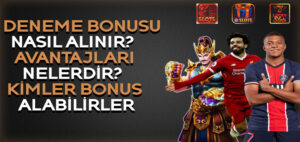Türkiye pazarında faaliyet gösteren deneme bonusu veren siteler, insanların para kazanma amacıyla siteleri deneme bonusları ile test etmelerine imkan tanımaktadır. Yeni siteleri ve güvenilir bahis firmalarını bulmak artık oldukça kolay. Bir bahis sitesinden bir defaya mahsus 300 TL’ye kadar bonus alma şansınız bulunmakta, ayrıca freespin seçeneğini de tercih edebilirsiniz. Örneğin, Sweet Bonanza’da 100 freespin deneyebilirsiniz.

100 TL deneme bonusu veren siteler, casino siteleri ve bahis firmaları olarak karşınıza çıkabilir ya da freespin veren siteler olarak da görülebilirler. Deneme bonusu veren siteleri incelemek ve faydalanmak için https://vardhmanivf.com/amp/ adresini ziyaret edebilirsiniz. Listelere ulaştıktan sonra neler yapabilirsiniz? En üstten en alta kadar tüm sitelerden canlı destek alabilir veya üye olduktan sonra hesabınıza yansıyan bonusları kullanmaya başlayabilirsiniz.
Deneme bonusu veren siteler yeni kullanıcıları için tam liste şunlardır;
- Betkom (300 ₺ Deneme bonusu)
- Betmarlo (300 ₺ Deneme bonusu)
- Smartbahis (200 ₺ Deneme bonusu)
- Hızlıbahis (200 ₺ Deneme bonusu)
- Oslobet (150 ₺ Deneme bonusu)
- Jojobet (150 ₺ Deneme bonusu)
- Youwin (100 ₺ Deneme bonusu)
- Eitbahis (100 ₺ Deneme bonusu)
- Maltcasino (100 ₺ Deneme bonusu)
Deneme bonusu
Deneme bonusu, Türkiye ve yurtdışında online bahis siteleri ve casino siteleri tarafından sunulan bir promosyon türüdür. Bu bonus, yeni üyelere bir bahis sitesine üye olduklarında veya belirli bir miktar para yatırdıklarında verilen ücretsiz bir bahis veya oyun deneme imkanıdır. Yaygınlaşma sebepleri arasında kullanıcıları çekmek, siteyi tanıtmak, yeni üyeler kazanmak ve müşterilerin deneme şansı elde etmelerine olanak tanımak bulunabilir. Bu tür bonuslar, bahis ve casino sektöründe rekabeti artırmak ve müşteri memnuniyetini sağlamak amacıyla sıkça kullanılmaktadır.
Deneme bonusu 2024, genellikle yaygın olarak kullanılan bir pazarlama stratejisidir. Bu tür bonuslar, kullanıcıların siteleri denemelerine ve platformlarını test etmelerine olanak tanır. Bu, kullanıcıların siteyi beğenmeleri ve daha uzun vadeli müşteri olmaları için bir teşvik oluşturabilir.
Ancak, deneme bonuslarının avantajlı olup olmadığı, sunulan koşullara, bonus miktarına, çevrim şartlarına ve genel olarak kullanıcı deneyimine bağlıdır. Kullanıcılar, bu tür bonusları değerlendirirken dikkatlice şartları incelemeli ve sitenin güvenilirliğini değerlendirmelidirler.

Bonus Veren Siteler
Bahis dünyasında, kullanıcı çekmek için en iyi stratejilerden biri bonus veren siteler kullanmaktır. Online bahis firmaları, bonuslarını vurgulayarak rakip firmalarla rekabet eder. En çok bonus veren siteler, daha fazla kullanıcıya ulaşmayı hedefler ve bu, zamanla firmalara yatırım olarak geri dönebilir.

Bedava bonus veren siteler, Türkiye ve yurt dışında oldukça popülerdir. Her zaman her siteye para yatırmak mantıklı olmayabilir, bu nedenle bu tür siteleri incelemek ve deneme için bonus veren siteler 2024 listelerini incelemek faydalı olabilir.
Casino siteleri genellikle bonus veren siteler değil, freespin veren siteler olarak karşımıza çıkabilir. Bu freespinlerle Sweet Bonanza, Gates of Olympus gibi oyunları ücretsiz olarak oynama imkanı bulunmaktadır. Bonus veren firmaların çevrim şartları veya yatırım şartları olabilir. Bonusları almadan önce kural ve şartlar kısmını inceleyerek sorun yaşamadan oynayabilirsiniz.
Bonus veren siteler ve freespin almak için liste şunlardır;
- Onwin (300 ₺ Deneme bonusu)
- Sahabet (300 ₺ Deneme bonusu)
- Betist (200 ₺ Deneme bonusu)
- Hızlıbahis (200 ₺ Deneme bonusu)
- Oslobet (150 ₺ Deneme bonusu)
- Kralbet (150 ₺ Deneme bonusu)
- Youwin (100 ₺ Deneme bonusu)
- Eitbahis (100 ₺ Deneme bonusu)
- Maltcasino (100 ₺ Deneme bonusu)
Deneme bonusu veren siteler forum
Deneme bonusu veren siteler forum, online bahis sitelerinde yeni üyeleri çekmek ve onlara siteyi denemeleri için verilen bir tür promosyon olarak karşımıza çıkar. Bu bonuslar genellikle bedava bahis kredisi veya bedava dönüşler şeklinde verilir ve bahis severlere ekstra kazanç sağlama fırsatı sunar. Ancak, birçok kişi bu deneme bonuslarını nasıl bulacaklarını veya hangi sitelerin en iyi bonusları sunduğunu bilmiyor olabilir.
İşte burada devreye deneme bonusu veren siteler forumları giriyor. Bu forumlar, bahis severlerin bir araya gelip deneme bonusu hakkında bilgi alışverişi yapabilecekleri, deneyimlerini paylaşabilecekleri ve en iyi bonusları bulabilecekleri platformlardır. Forumlarda diğer kullanıcıların yorumlarını okuyarak hangi sitelerin en iyi deneme bonuslarını sunduğunu ve hangi sitelerden uzak durulması gerektiğini öğrenebilirsiniz.
Bu forumlarda dikkat etmeniz gereken nokta, herkesin farklı deneyimlere sahip olabileceğidir. Bu nedenle, bir sitenin deneme bonusuyla ilgili kötü bir yorum gördüğünüzde direkt olarak o siteyi eleyip, bir diğerine yönelmek yerine, genel bir fikir edinmek için birkaç farklı kullanıcının yorumlarını okumanız önemlidir. Ayrıca, bonusların yanı sıra sitenin genel güvenilirliği, oyun çeşitliliği ve müşteri hizmetleri gibi faktörleri de göz önünde bulundurmanız daha sağlıklı bir seçim yapmanıza yardımcı olacaktır.
| ForumNeyine: | Bahis Forumu | 9.5/10 |
| Bahisedair: | Casino Forumu | 9.5/10 |
| Betortam: | Rulet Forumu | 9.5/10 |
| Bilgibizden: | Bahis Bilgi Forumu | 9.5/10 |
| BetxForum: | Yabancı İçerik | 9.5/10 |
| ForumBahis: | Forum bonusları | 9.5/10 |
Deneme Bonusu Veren Bahis Siteleri
Deneme bonusu veren bahis siteleri, genellikle yeni üyeleri çekmek ve siteyi denemeleri için bir teşvik sağlamak amacıyla bu tür bonusları sunarlar. Ancak, hangi bahis sitelerinin deneme bonusu sunduğu ve bu bonusların detayları, siteler arasında farklılık gösterir. İşte bu tür bahis sitelerini bulmak ve deneme bonusu almak için izleyebileceğiniz bazı adımlar:
İnceleme Siteleri Bahis inceleme siteleri, farklı bahis sitelerini karşılaştırarak sundukları bonusları ve diğer özellikleri detaylı bir şekilde inceleyebilir. Bu tür sitelerden alınan bilgiler, size hangi bahis sitelerinin deneme bonusu sunduğu konusunda bir fikir verebilir.
Bahis Forumları Bahis forumları, kullanıcıların deneyimlerini paylaştığı ve önerilerde bulunduğu yerlerdir. Burada, diğer kullanıcıların deneme bonusları hakkında bilgi paylaşımlarını bulabilirsiniz.
Sosyal Medya Bahis siteleri, sosyal medya platformlarında da faaliyet gösterir ve özel bonus tekliflerini duyurabilir. Sosyal medya hesaplarını takip ederek güncel kampanyalardan haberdar olabilirsiniz.
Doğrudan Site Ziyareti Birçok bahis sitesi, ana sayfalarında veya promosyonlar bölümünde güncel bonus tekliflerini listeler. Bu nedenle, ilgili bahis sitelerinin resmi web sitelerini ziyaret ederek güncel bonus tekliflerini inceleyebilirsiniz.
Ancak, unutmayın ki bahis yapmadan önce seçtiğiniz sitenin lisanslı, güvenilir ve kullanıcı dostu olduğundan emin olun. Ayrıca, bonusların şartlarını dikkatlice okuyun, böylece bonusları doğru bir şekilde kullanabilir ve çekebilirsiniz.
| Deneme Bonusu Veren Bahis Siteleri | ||
|---|---|---|
| Betkom: | 250 TL & 100 FS⚡ | |
| Onwin: | 200 TL & 100 FS⚡ | |
| Kralbet: | 100 TL & 100 FS⚡ | |
| Betwoon: | 111 TL & 100 FS⚡ | |
| Resimi Sitemiz: | https://vardhmanivf.com/ | |
Bedava bonus
Bedava Bonus müşterilerine sunduğu en popüler tekliflerden biridir. Bedava bonuslar, genellikle yeni üyelere verilir ve çeşitli oyunlarda kullanılmak üzere verilen ücretsiz kredi miktarlarıdır. Bu bonuslar, oyuncuların siteyi denemelerine ve potansiyel kazanç elde etmelerine olanak tanır.
Bedava bonus alma şartları siteye göre değişiklik gösterebilir. Bu nedenle, bir bonus teklifiyle karşılaştığınızda dikkatlice şartları okumanız önemlidir. Bazı bonuslar için belirli bir miktar para yatırmanız gerekebilirken, bazıları sadece üyelikle beraber verilebilir. Ayrıca, çevrim şartları gibi belirli koşulları yerine getirmeniz gerekebilir.
Bedava bonus tekliflerinden en iyi şekilde faydalanmak için, farklı bahis sitelerinin ve casinoların sunduğu bonusları karşılaştırabilir ve en avantajlı olanı seçebilirsiniz. Bu sayede, oyun oynarken ekstra kazanç elde etme şansınızı artırabilirsiniz. Ayrıca, her zaman güvenilir ve lisanslı siteleri tercih etmeniz de önemlidir.
Bahis Siteleri
Bahis siteleri severlerin kaçak bahis ve spor müsabakaları ve diğer çeşitli etkinlikler üzerine bahis yapabildiği platformlardır. Bahis siteleri, kullanıcılarına geniş bir yelpazede farklı spor dalları, ligler ve turnuvalar üzerine bahis yapma imkanı sunar.
Bahis siteleri genellikle kullanıcılarına yüksek oranlar ve çeşitli bonus avantajları sağlar. Bu siteler arasında rekabet oldukça yüksek olduğu için, bahis severler farklı siteler arasında karşılaştırma yaparak en avantajlı olanı seçebilirler.
Bahis siteleri aynı zamanda canlı bahis imkanı da sunar. Bu sayede kullanıcılar, maçın herhangi bir anında bahis yapma fırsatına sahip olurlar. Ayrıca, mobil uygulamaları sayesinde bahis severler istedikleri zaman ve istedikleri yerden bahislerini gerçekleştirebilirler.
Casino Siteleri
Casino siteleri kaçak siteler de bulunur. Bu siteler, genellikle birçok farklı casino oyunu seçeneği sunar ve kullanıcılarına yüksek kazanç fırsatları sunar. Türkiye’de birçok farklı casino sitesi bulunmaktadır ve kullanıcılar genellikle bu siteler arasında tercih yaparken dikkatli olmalıdırlar.
Bahis siteleri, genellikle spor bahisleri ve canlı bahis seçenekleri sunarlar. Ancak casino siteleri, daha çok slot oyunları, poker, rulet, blackjack gibi klasik casino oyunlarını içerirler. Aynı zamanda canlı casino seçenekleri de sunan bu siteler, gerçek krupiyeler eşliğinde oyun oynama imkanı sunar.
Kullanıcıların güvenilir ve lisanslı siteleri tercih etmeleri önemlidir. Ayrıca sitelerin sunduğu bonus seçenekleri, para yatırma ve çekme yöntemleri de dikkate alınmalıdır. Kullanıcı yorumları ve deneyimleri de incelenerek en doğru casino sitesi seçimi yapılabilir.
Yasal siteler için referanslarımız şunlardır : Ref – 1 Ref – 2 Ref – 3
 Deneme bonusu veren siteler
Deneme bonusu veren siteler